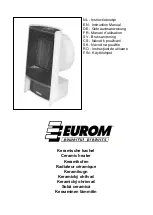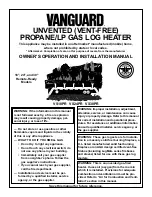
8
In case of internal overheating,
the overheating safeguard
will switch the heater off. This may occur if the heater
cannot give off enough heat or if it cannot draw in enough fresh air. As mentioned above, this is generally caused
by (partially) covering the heater or obstructing the air intake and/or outlet grills or installing the heater too close to
a wall or something similar. When the overheating safeguard switches the heater off, you need to turn the switch
to the ‘O’ position (off) and remove the plug from the socket. Allow the heater to cool down and make sure that
whatever caused the overheating is removed or amended. The heater can then be reused. If the problem persists
or if you cannot find an obvious cause for the overheating, turn the heater off immediately and take the plug out of
the socket. Contact a service point for repair.
If the heater does not work...
Check that the plug is correctly inserted into the socket and that the socket has current.
Check (after switching off the heater and removing the plug from the socket) whether the heater is
obstructed in any way. Are the intake and/or outlet grills clogged up, is the fan in any way obstructed, can
the heater take in and blow out air freely? Never open the heater yourself; internal repairs may only be
carried out by a certified electrician!
Does the heater switch off when in operation? Check if the tipping safeguard or the overheating safeguard
are making it switch off.
See ‘Safety features’.
If the aforementioned suggestions do not solve the problem, please notify your vendor or a certified
electrician for repair.
Cleaning and Maintenance
Keep the heater clean. Deposits of dust and dirt in the appliance are a common cause of overheating so these
should regularly be removed! Switch off the heater, remove the plug from the socket and allow the heater to cool
down before cleaning or carrying out maintenance work.
Wipe the outside of the heater regularly with a dry or slightly damp cloth. Do not use aggressive soaps,
sprays, cleaners or abrasives, waxes, polishes or chemical solutions!
Use a vacuum cleaner to carefully remove any dust and dirt from the grills and ensure that the air intake and
outlet openings are clean. Be careful not to touch or damage any internal parts during cleaning.
The heater contains no other parts which need maintenance. The manufacturer has ensured that the motor
has sufficient oil for its working life so there is no need for oil to be added.
At the end of the season, store the cleaned heater upright, in the original packaging if possible, in a cool, dry
and dust-free place.
If the heater becomes worn or is damaged beyond repair, do not dispose of it with the household waste.
Take it to your local authority's collection point for electrical appliances where any reusable materials will be
collected and redistributed.
CE - statement
Euromac bv.
– Genemuiden-NL hereby declares that the following product, the ceramic electrical heater
with fan
, brand name
SAFE-t-HEATER
, type Mini500, complies with the LVD-guideline 2006/95/EC and the
EMC-guideline 2004/108/EC and that it complies with the following standards:
EN 60335-2-30:2009+A11 :2012
EN 55014-1 :2006/+A1 :2009/+A2 :2011
EN 60335-1 :2012
EN 61000-3-2 :2006/+A1 :2009/+A2 :2009
EN 62233 :2008
EN 61000-3-3 :2008
EN 55014-2 :1997/+A1:2001/+A2 :2008
Genemuiden, 14-01-2014
W.J. Bakker, alg. dir.









































